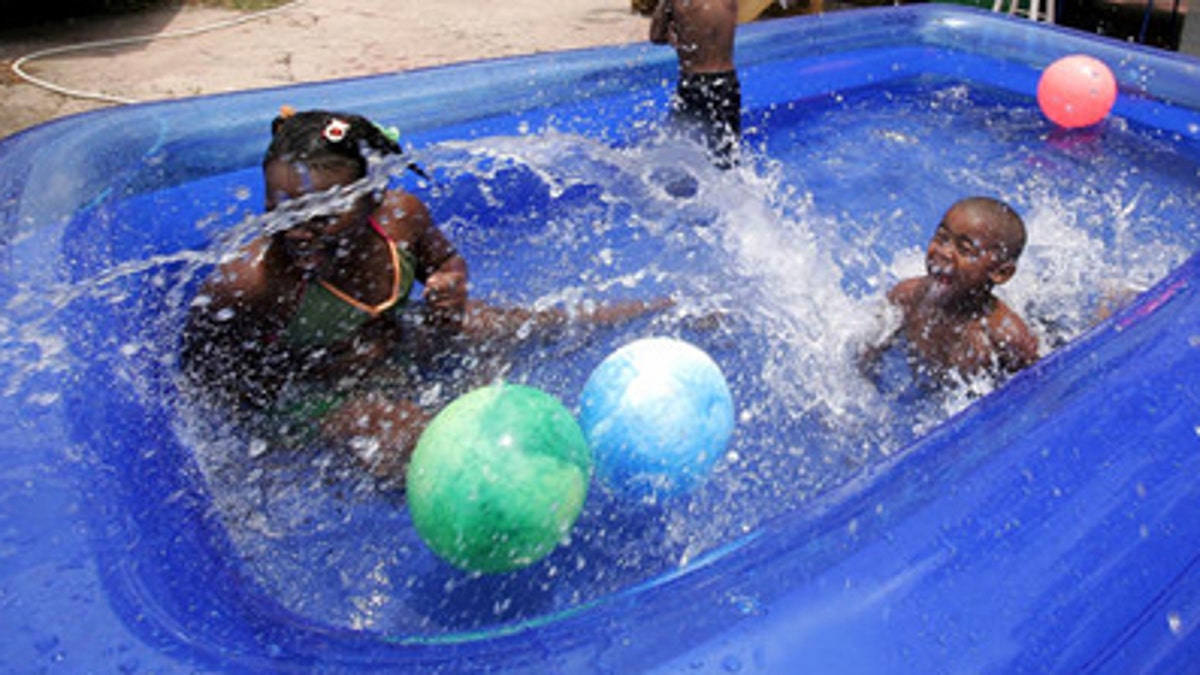
Demondtrell Handy, 8, left, Jockan Jordan, 3, and Kendell Francis, 5, play in a swimming pool between two FEMA trailers in New Orleans on Tuesday, May 30, 2006. (AP)
With the hot summer months arriving, a new study warns that caregivers need to be thinking about the drowning hazards posed by portable pools, including inflatable and wading pools.
"Parents need to be aware that these pools can present the same risks for drowning, especially for young children, as in-ground pools" which are typically thought of as a greater safety hazard, said study author Dr. Gary Smith.
He and his colleagues found 209 recorded cases of kids' drowning in these pools between 2001 and 2009, most of them occurring in summer.
"That's a child every five days that is drowning in a backyard portable pool during the summer months," Smith, head of the Center for Injury Research and Policy at Nationwide Children's Hospital in Columbus, Ohio, told Reuters Health.
While this doesn't suggest that families shouldn't use inflatable pools or wading pools, parents, he said, need to "put some thought into the safety issues when they go to the store, pick one of these up, and put them up in their backyard."
Smith's team looked back at data compiled by the U.S. Consumer Product Safety Commission for cases of drowning or near-drowning in these types of pools reported to the commission.
Over the nine-year period, they found records of 209 deaths from submersion and 35 non-fatal cases in kids age 11 and younger. The number of drowning cases increased between 2001 and 2005, but has leveled off in recent years.
Almost all of those happened in kids less than 5 years old, and most were in the kid's own yard and during the summer months.
The authors found cases of drowning when kids opened the doors of their houses and climbed into the pool using a ladder or another nearby object, as well as examples of kids playing in the pool when parents were nearby but were distracted by chores or a phone call.
Parents "can't say they're supervising having a couple drinks at a pool and chatting with their friends or talking on a cell phone," said Dr. Linda Quan, a drowning expert at Seattle Children's Hospital.
"Supervision has to be constant...and for a very young child, even within arm's reach," Quan, who was not involved in the research, told Reuters Health.
Parents can add a layer of safety by making sure kids have a life jacket on whenever they're by the pool, Quan added.
And when they're not outside watching their kids, parents have to make sure they have no access to the pool, researchers said.
One of the simplest ways to do that is to empty the pool, especially for smaller pools, Quan explained.
Parents can also put an isolation fence around the pool and make sure there's no way kids can reach the ladder in bigger inflatable pools, Smith said.
"Two-thirds of the children who drowned gained access to the portable pool through the ladder," he said. "Blocking access is the first step."
The authors note in Pediatrics that local jurisdictions are responsible for setting pool codes and enforcing them, and that only some require fencing around portable pools.
A cover for inflatable pools won't necessary help, the researchers said - and in at least one case, a pair of kids included in the study drowned together when they got tangled in a pool cover.
Getting parents to follow all of these prevention measures "is a challenge," Dr. Ruth Brenner, who has studied drowning at the Eunice Kennedy Shriver National Institute of Child Health and Human Development, told Reuters Health.
"But it does represent a significant risk for children. Children can drown in very small amounts of water," said Brenner, who was not involved in the new paper.
Smith said the most important message is that parents need to take the risks of these pools very seriously — even if the pool is small and only has a couple feet of water.
"If you are on the playground equipment and you fall, you generally get another chance," Smith said. "The problem with submersion underwater is it's very quick...and once (a kid's) heart and breathing stops it's very difficult to revive them," he said. "You don't get a second chance."
